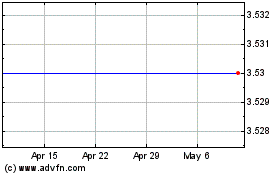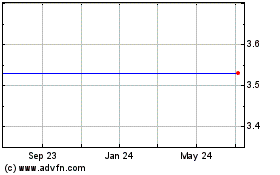Kadmon to Present Additional Data Demonstrating Tesevatinib Safety for the Treatment of Polycystic Kidney Disease at ASN Kidn...
November 19 2016 - 11:15AM
Business Wire
-- Data Support Tesevatinib Safety While
Highlighting the Need for Innovative Methods to Measure Renal
Function in Clinical Trials --
Kadmon Holdings, Inc. (NYSE:KDMN) (“Kadmon” or the “Company”)
today announced additional data from its ongoing Phase 2a clinical
study demonstrating the safety of tesevatinib, the Company’s oral
tyrosine kinase inhibitor, for the treatment of autosomal dominant
polycystic kidney disease (ADPKD). The data will be presented in a
poster session on Saturday, November 19 at the American Society of
Nephrology (ASN) Kidney Week 2016 in Chicago, IL.
Recent findings from Kadmon’s ongoing Phase 2a study in patients
with ADPKD have demonstrated that tesevatinib is well tolerated and
have also identified tesevatinib 50 mg once daily (QD) as the
optimal dose to treat ADPKD.
New data reported in the poster indicate that tesevatinib is a
new member of a group of drugs known as MATE 1/2-K transporter
inhibitors, such as cimetidine, which mildly increase levels of
serum creatinine. Normally, an increase in serum creatinine can be
used to indicate kidney damage, but in the case of MATE 1/2-K
inhibitors, these serum creatinine increases occur without
clinically meaningful alterations in renal function.
Specifically, new data demonstrated that serum creatinine levels
in tesevatinib patients increased by 10% to 14% during the first 28
days of treatment and reversed upon treatment discontinuation.
Importantly, levels of cystatin C, another measure of renal
function, were relatively unchanged during the same period. In
vitro studies demonstrated that tesevatinib potently inhibits
MATE1/2-K transporters at tesevatinib concentrations achieved with
the 50 mg QD dose. Therefore, MATE inhibition by tesevatinib may
explain mild serum creatinine increases associated with tesevatinib
treatment.
“Kadmon has identified a contradiction in PKD drug development:
MATE transporters such as tesevatinib increase levels of
creatinine, the standard measure of PKD drug efficacy, but without
clinically relevant effects on kidney function,” said James Tonra,
Ph.D., Senior Vice President, Nonclinical Development at Kadmon and
first author of the poster. “These findings further characterize
the safety of tesevatinib while highlighting the need for
alternative methods to evaluate kidney function in PKD drug
development.”
“We believe these findings support the continued development of
tesevatinib for PKD,” said John Ryan, M.D., Ph.D., Executive Vice
President and Chief Medical Officer at Kadmon. “Kadmon has had
discussions with the FDA to develop innovative methods to
demonstrate drug safety and efficacy in PKD, a major unmet medical
need. These discussions will have important implications for
clinical trial designs for tesevatinib as well as other therapies
in development for renal diseases, especially MATE inhibitors.”
Kadmon continues to expand its work on tesevatinib at 50 mg QD
in its ongoing Phase 2a study to evaluate the drug’s safety in
patients with larger kidneys, indicative of more severely
compromised renal function. Data from the first six patients in
this cohort are also discussed in the ASN Kidney Week poster. In
2017, Kadmon plans to initiate a placebo-controlled study of
tesevatinib in ADPKD as well as to initiate a dose-finding study in
the pediatric form of the disease, autosomal recessive PKD.
About Kadmon Holdings, Inc.
Kadmon Holdings, Inc. is a fully integrated biopharmaceutical
company focused on developing innovative products for significant
unmet medical needs. We have a diversified product pipeline in
autoimmune and fibrotic diseases, oncology and genetic
diseases.
Safe Harbor Statement
This press release contains forward-looking statements. Such
statements may be preceded by the words “may,” “will,” “should,”
“expects,” “plans,” “anticipates,” “could,” “intends,” “targets,”
“projects,” “contemplates,” “believes,” “estimates,” “predicts,”
“potential” or “continue” or the negative of these terms or other
similar expressions. Forward-looking statements involve known and
unknown risks, uncertainties and other important factors that may
cause our actual results, performance or achievements to be
materially different from any future results, performance or
achievements expressed or implied by the forward-looking
statements. We believe that these factors include, but are not
limited to, (i) the initiation, timing, progress and results of our
preclinical studies and clinical trials, and our research and
development programs; (ii) our ability to advance product
candidates into, and successfully complete, clinical trials; (iii)
our reliance on the success of our product candidates; (iv) the
timing or likelihood of regulatory filings and approvals; (v) our
ability to expand our sales and marketing capabilities; (vi) the
commercialization of our product candidates, if approved; (vii) the
pricing and reimbursement of our product candidates, if approved;
(viii) the implementation of our business model, strategic plans
for our business, product candidates and technology; (ix) the scope
of protection we are able to establish and maintain for
intellectual property rights covering our product candidates and
technology; (x) our ability to operate our business without
infringing the intellectual property rights and proprietary
technology of third parties; (xi) costs associated with defending
intellectual property infringement, product liability and other
claims; (xii) regulatory developments in the United States, Europe
and other jurisdictions; (xiii) estimates of our expenses, future
revenues, capital requirements and our needs for additional
financing; (xiv) the potential benefits of strategic collaboration
agreements and our ability to enter into strategic arrangements;
(xv) our ability to maintain and establish collaborations or obtain
additional grant funding; (xvi) the rate and degree of market
acceptance of our product candidates; (xvii) developments relating
to our competitors and our industry, including competing therapies;
(xviii) our ability to effectively manage our anticipated growth;
(xix) our ability to attract and retain qualified employees and key
personnel; and (xx) our ability to achieve cost savings and other
benefits from our efforts to streamline our operations and to not
harm our business with such efforts. More detailed information
about Kadmon and the risk factors that may affect the realization
of forward-looking statements is set forth in the Company's filings
with the U.S. Securities and Exchange Commission (SEC), including
the Company's Quarterly Report on Form 10-Q filed pursuant to
Section 13 of the Securities Exchange Act of 1934, as amended, with
the SEC on November 9, 2016. Investors and security holders are
urged to read these documents free of charge on the SEC's web site
at www.sec.gov. The Company assumes no obligation to publicly
update or revise its forward-looking statements as a result of new
information, future events or otherwise.
View source
version on businesswire.com: http://www.businesswire.com/news/home/20161119005011/en/
For Kadmon Holdings, Inc.Investor RelationsEllen Tremaine,
646-490-2989ellen.tremaine@kadmon.comorMediaMaeve Conneighton,
212-600-1902maeve@argotpartners.com
Kadmon (NYSE:KDMN)
Historical Stock Chart
From Mar 2024 to Apr 2024

Kadmon (NYSE:KDMN)
Historical Stock Chart
From Apr 2023 to Apr 2024
